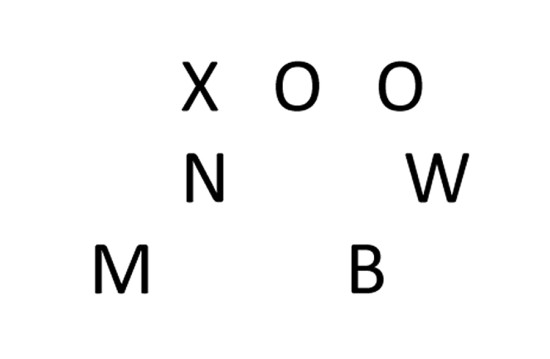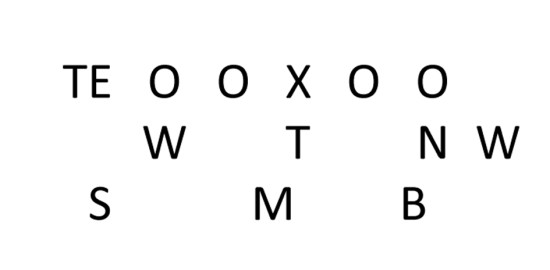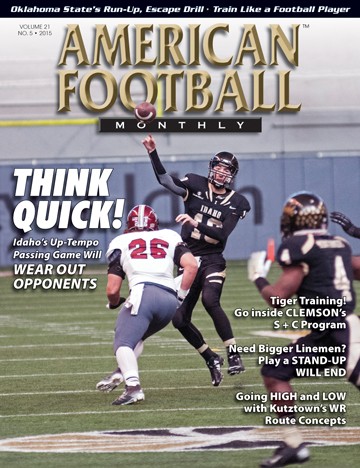Are You Short on Big Linemen? If so, you should consider playing a stand-up Will End
by: Jim PlaceHead Coach, Dayton Ponitz High School©
More from this issue
Are you like most programs that have a shortage of big players with most of those needed on the offensive and defensive line? Then playing a standup Will End may be something that can help your defense. We have used the standup Will End for over 30 years and the results have been well worth it.
Physical Attributes - We used to look at our back-up RB or DBs, but then we realized that there is no definition of who can play this position. It has become a position of its own. In past years we have actually gone to a double Will End. This means that we only need two down defensive lineman which frees up more of the big guys for the offensive line.
Alignment - Crowd the LOS in a sprinter’s two-point stance. The arms are hanging loose. The inside foot is on the outside foot of the weak offensive tackle. We like to play the Will to the one technique. Many offenses see what appears to be a huge bubble, but we feel it is one of our strongest spots as we have very solid gap control with a fast flow Mike linebacker coming over the top (Diagram 1).

Diagram 1
You can also play this position vs. a TE. We often play a double Will (Diagram 2).
Stance and Takeoff – The player should be in a two-point stance with his outside foot up. Crowd the LOS. All his weight is on the outside foot. The eyes are glued to the ear hole of the OT. The arms are hanging loose and he is ready for a great take off. On the snap, he will step with his inside foot directly at the ear hole of the OT with the hands out in front. The inside hand should get as much of the OT as possible and the outside hand should grab the outside shoulder of the OT. Get cloth, if possible.

Diagram 2
Reads - The eyes are glued on the OT as he comes up to the line. We realize that most people read the movement of the ball. Through experience, we have found that the Will End plays much better when he locks on the OT. The great ends have the ability to play in a small world and block out everything but the OT’s first step. Some more specific reads:
• If the OT blocks inside or straight ahead on our OSLB, continue firing through where his ear hole was and get as tight to the LOS as possible. The first threat is a trapping offensive lineman or an iso FB. Use your wrong arm on the O-lineman, bringing the wrong arm up and into him. In these situations, the job is to make the play bounce to the OSLB who is coming over the top and the Mike linebacker who is fast flowing. If the play is away and no one is blocking the Will End, he should chase with a passion into the LOS. We expect him to make plays all over the field. One thing we learned from experience is that it is not natural to a player to bend into the LOS. They want to stay in the open area. They have to realize that every step into the LOS is a huge advantage to running the RB down from the backside.
• If the OT blocks out on the Will End, make sure the gap is protected. Do not get blown out. This widens the hole for the LB’s fill. Sink the hips and get under the OT. Do not cross the OT’s face but go inside until the ball hits the LOS.
• If the OT tries a hook, the Will End will read the first step and fly upfield and to the outside. This should happen the second the inside foot hits the ground. Get the outside hand on his shoulder pad and use his force to push outside. If a Jet motion man is coming,it is OK to overplay the Jet sweep.
• The outside LB also reads the OT and reads off the Will End. For specific QB reads:
- If the OT blocks on the Will End, he should fly over the top as tight as possible. Gaps have now been traded with the Will End.
- If the OT blocks out on the Will End, the outside LB should come flying into the hole. Get ready to wrong arm.
Advantages:
1. A perfect spot for that undersized player that you cannot find another spot on the field.
2. Mismatch big OT’s with speed.
3. Playmaker all over the field.
4. The offense must game plan and make adjustments in seven days.
5. Puts a speed player on the field who can grab and drop on stunts.
Stunts:
1. Tap in – The Will goes to the inside gap and the OSLB to the outside gap.
2. Tap out – Will goes to the outside gap and the OSLB to the inside gap.
3. Slam – Will hits and holds the OT and the OSLB goes to the inside gap.
Practice time: The Will End generally practices with the D-line but in some years we have had a volunteer coach.
Drills:
1. Stance and starts.
2. OT reads.
3. Down block into the LOS drill.
4. OT hook drill.
5. OT block out drill.
6. The other drills are standard D-line drills - pass rush, hands on, lock out, etc.
About the Author:
Jim Place has been an educator for 46 years. He is a member of the Ohio High Football Coaches Hall of Fame and currently teaches nine different character education classes at the University of Dayton. His website is www.jimplaceservices.com.
Find more articles like tthis:
Drills Report: 5 Drills to Improve Your Defensive Line
without Using helmets or Shoulder Pads – April, 2013
Stopping the Run With the Odd Front Defense – January, 2012
Sack Attack: Troy’s Defensive Ends Coach Randy Butler
Revels Their Strategy to Attack the QB – April, 2011







